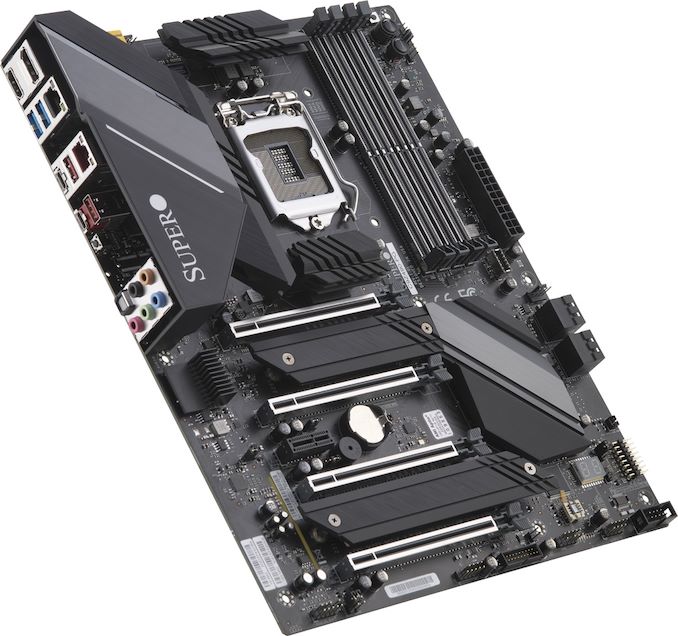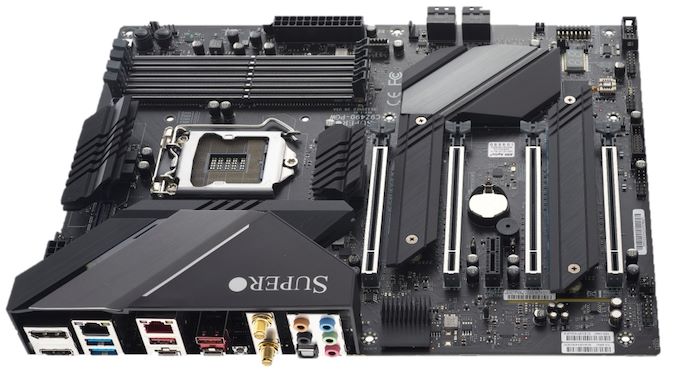The Intel Z490 Overview: 44+ Motherboards Examined
by Gavin Bonshor on April 30, 2020 10:00 AM ESTSupermicro is a name synonymous with high-grade professional workstation motherboards. Although they tend to release just a small handful of models for the desktop market, it has some models ready for Z490. We've seen quite a few Supermicro motherboards over the years, with the most recent desktop offering via the Supermicro C9Z390-PGW which included a PLX chip and 10 G Ethernet. At present, Supermicro has two ATX sized models ready in preparation for Intel's Comet Lake 10th gen desktop processors, one with Wi-Fi 6 capability and one without.
Supermicro C9Z490-PGW & C9Z490-PG
Both the Supermicro C9Z490-PGW and Supermicro C9Z490-PG share the same core feature set, with the only difference being that the C9Z490-PGW includes an Intel Wi-Fi 6 wireless interface, while the PG does not. Both include a premium controller and feature set with the most notable coming from Broadcom PEX8747 PLX chip for superior multi-graphics card support and PCIe bifurcation. Other exciting features include two PCIe 3.0 x4 M.2 slots, an Aquantia 10 G Ethernet controller, and support for up to 128 GB of DDR4-4000 memory.

The Supermicro C9Z490-PG Motherboard
Dominating the lower portion of the C9Z490-PGW and C9Z490-PG are four full-length PCIe 3.0 slots which operate at x16/x0/x16/x0 and x8/x8/x8/x8 which is made possible via a Broadcom PEX8747 PLX chip. At present this is the only Z490 motherboard that includes a PLX chip, which makes it unique for users looking to run 4-way NVIDIA SLI, or leverage the extra PCIe lanes for high-bandwidth PCIe 3.0 devices. There is also a single PCIe 3.0 x1 slot. Across its four memory slots, both models support up to DDR4-4000 with a total capacity of 128 GB. Focusing on storage, there is a pair of PCIe 3.0 x4 M.2 slots which each come with a heatsink, and four SATA ports with support for RAID 0, 1, 5, and 10 arrays. Both models are using a 6+2 power delivery with an XDPE122284C PWM controller, and TDA21490 power stages for the CPU element.

The Supermicro C9Z490-PGW Motherboard with Wi-Fi 6
On the rear panel is one USB 3.2 G2 20 Gbps Type-C, one USB 3.2 G2 10 Gbps Type-C, two USB 3.2 G2 10 Gbps Type-A, and two USB 3.2 G1 Type-A ports. Controlling the five 3.5 mm audio jacks and S/PDIF optical output is a Realtek ALC1220 HD audio codec. At the same time, one Ethernet port is powered by an Aquantia AQC107 10 G controller, while an Intel-based Gigabit controller controls the other. A small clear CMOS button is present with an HDMI 2.0a and DisplayPort 1.2 video output pairing. Last but not least on the C9Z490-PGW is an Intel Wi-Fi 6 wireless interface, likely the AX200 with BT 5.0 support.
Both the Supermicro C9Z490-PGW and C9Z490-PG are currently unique to the Z490 product stack with the inclusion of a Broadcom PEX8747 PLX controller, which allows for more PCIe bandwidth in slots which has a variety of use cases. It adds some flexibility to the Z490 chipset, something all other models at launch isn't offering. The Aquantia 10 G Ethernet controller is a common find on Supermicro's premium desktop motherboards, and its styling is very sleek and uniformed with its black and grey theme. The only pitfall is in the memory support, with the official backing for up to DDR4-4000 which is the lowest of any Z490 model we've overviewed for launch. The Supermicro C9Z490-PGW has an MSRP of $395, while the C9Z490-PG without Wi-Fi costs $375.










52 Comments
View All Comments
Tomatotech - Friday, May 1, 2020 - link
Get better hubs then. At least mains powered hubs.I understand not everyone has wifi/ ethernet printers, bluetooth / radio mouse / keyboard / headset, or usb hubs in their monitors, but there does seem to be slightly less need for lots of USB ports compared to a few years ago.
Beaver M. - Saturday, May 2, 2020 - link
Not an option due to several reliability issues and issues recognizing claimed "better hubs" in the first place. Even well known big companies produce crappy USB hubs.As a normal user I have
a printer
a mouse
a keyboard
a gamepad with USB dongle
a USB headset
an external HDD
several external USB ports for USB sticks, temporary Bluetooth dongles, charging devices, etc., which can be up to 4 at a time
Specialized
things:
a joystick
a USB microphone interface
Not really unusual.
Add webcams, card readers, Wifi adapters and many other not really unusual stuff and you still wont have anything rare.
Lots of USB ports are important. Period. And it doesnt even matter if its an ATX board or a NUC. They are always very important.
duploxxx - Friday, May 8, 2020 - link
wow so many USB that you need in the back, how long have you been searching on the internet to find all of these? You can buy cases that also serve USB, or backend brackets….a printer : wireless
a mouse - keyb sure
a gamepad, connected from the back? often to short cable
a USB headset ---- audio connection which you can link with USB mic….
a USB External HDD.... zzz one that you can put away for backup or just horrible initial design from storage perspective
several external USB.... all front unless you Always use your usb dongles and put them in the back "loooooool"
joystick.... yeah use gmaepad and joystick at the same time. same as the gamepad regarding cable length
webcam... easy connection in monitor hub
card readers... again in the back used all day right....
USB wifi adapters? really are you joking?
in other words lots of pathetic feedback... learn to design a desktop computer
Beaver M. - Saturday, May 2, 2020 - link
Low USB port count has been a problem far longer than 5 years.Only Asus seem to have gotten the hint at some point, but Asus is crappy quality and CS.
Seeing Gigabyte adding enough now is a good sign, because they usually were the ones having the least amount of them.
I agree on the hubs. Not only do they die, some of them even nuke your mainboards USB ports through feedback loops. Not to mention they always either have connection problems or issues with sleep or hibernation.
Chaitanya - Friday, May 1, 2020 - link
Whats wierd is most of the boards from Asus and Asrock have multiple 40mm fans to cool VRMs while they seem to stick solid slabs of Aluminium and calling it a day unlike Gigabyte and Msi(on top end atleast) who have proper finned heatsinks.Deicidium369 - Friday, May 1, 2020 - link
The only reason people think Asus are a high end manufacturer is their price and the truckloads of equipment they give to anyone with more than 10 subs on Youtube. Gigabyte or go home.Beaver M. - Saturday, May 2, 2020 - link
Agreed. Same with ASRock and their crappy customer support and massive USB issues.Gigabyte always tried to add important features. Remember when they added their "extra ounces" of copper? All other manufacturers whined that it doesnt do anything and Gigabyte should stop because its a "waste of resources". LOL!
Now they all do it because it makes the mainboard much more reliable.
Sure, they dont have the best OC boards, but in the last few years OC has become very niche, because you cant really OC CPUs well anymore, unless you want to use LN or custom liquid coolers.
Andrew LB - Sunday, May 10, 2020 - link
I've been building/repairing/upgrading computers for people for close to 30 years and I've had more problems with Gigabyte than any other current major brand. Abit was even worse but they're long gone. I'm willing to bet that those of you who say a company has bad customer service was due to you contacting them via e-mail. Pickup the phone next time and i bet it will go much easier.Best CS from my experience is EVGA.
taz-nz - Saturday, May 2, 2020 - link
To many board still don't have attached back plates, should be standard now.Nice to see gigabyte bring proper finned heatsink to Mid range board, pity so many other boards still have cosmetic lumps of aluminum, instead of proper VRM heatsinks, and worse that so many still choose to cover the those so called heatsinks with cosmetic plastic covers that only reduce airflow and hurt thermal performance more, while also interfering with large air cooler fitment.
Oxford Guy - Saturday, May 2, 2020 - link
"What's interesting is how similar the Z490 and Z390 chipsets are in terms of specifications, which adds the question of why Intel has opted for a new socket, on what is effectively a refresh of its 14 nm process node."Baffling is a better word than interesting.
If AMD weren't so competitive then it would make more sense to paint oneself into a corner even more.